Hans Rudi Erdt
Hans Rudi Erdt (31 March 1883 – 24 May 1918)[1][2] was a German graphic designer, lithographer and commercial artist known for his contributions to the Sachplakat movement created by Lucian Bernhard.[3][4][5] His work at the prestigious Hollerbaum und Schmidt art printing company along with Edmund Edel, Hans Lindenstadt, Julius Klinger, Julius Gipkens, Paul Scheurich and Karl Schulpig[6] make him one of the most important representatives of German poster art between 1906 and 1918.[7][8][9] Erdt has also been recognized for his innovative use of typography in posters.[10]
Hans Rudi Erdt | |
|---|---|
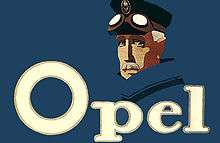 Erdt advertisement poster for Opel Racing, 1911 | |
| Born | 31 March 1883 Benediktbeuern, Bavaria |
| Died | 24 May 1918 (aged 35) Berlin |
| Nationality | German |
| Occupation | Graphic designer, lithographer |
| Known for | Sachplakat movement, poster propaganda, advertising |
Life and work
Born in Benediktbeuern, Bavaria,[11] he trained as a lithographer and became a student of Maximilian Dasio at the Munich School of Applied Arts. He joined Hollerbaum und Schmidt around 1908, becoming part of the "Berlin School",[12] where he created what is considered one of the most enduring examples of Sachplakat, an advertisement for the nascent racing division of the Opel car manufacturer.[8][13] During World War I he created propaganda posters for the German State Film Committee,[14][15][16][17] as well as promotional posters for propaganda films,[18] some of which, like U Boote Heraus! became quite famous at the time.[19][20]
His advertising work varied, from Nivea[21][22] to illustrated weekly newspapers such as Die Woche,[23] tourism and travel events[24] and tobacco companies such as Batschari, Manoli and Mahala Problem.[25]
Erdt died in Berlin of tuberculosis at the age of 35.
Gallery
Advertisements
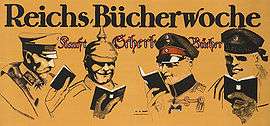 Reichs-Bücherwoche, ca. 1915.
Reichs-Bücherwoche, ca. 1915. Engelhardt Cigarettes, 1915
Engelhardt Cigarettes, 1915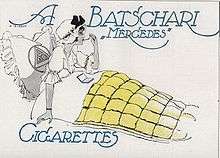 Batschari Mercedes Cigarettes, 1914
Batschari Mercedes Cigarettes, 1914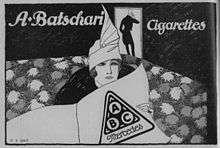 Batschari Jugend, 1914
Batschari Jugend, 1914 Den Berliner Börsen-Courier, 1913
Den Berliner Börsen-Courier, 1913 Münchner Kindl Keller, 1913
Münchner Kindl Keller, 1913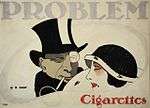 Mahala Problem, 1912
Mahala Problem, 1912 Never fail, 1911
Never fail, 1911 Manoli, 1911
Manoli, 1911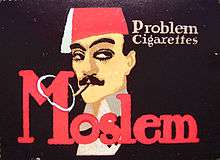 Moslem Cigarettes, 1908
Moslem Cigarettes, 1908 Maxim Bar, 1907
Maxim Bar, 1907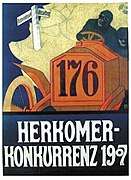 Herkomer Race, 1907
Herkomer Race, 1907
World War I film propaganda posters
 Hell fight on the Aisne River
Hell fight on the Aisne River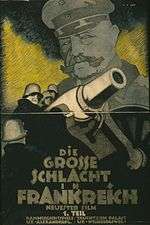 The Great Battle in France
The Great Battle in France U Boote Heraus!
U Boote Heraus! Der Frieden mit der Ukraine, 1918
Der Frieden mit der Ukraine, 1918 Bei Unseren Blaujacken, 1917
Bei Unseren Blaujacken, 1917
Notes
- A few German sources place Erdt's death in different years: Alexander Kauther - 1925; the German National Library - 1924. The most commonly used date is 1918
- "ULAN Full Record Display (Getty Research) - Hans Rudi Erdt". Union List of Artist Names. Getty. Retrieved 7 December 2012.
- Consuegra, p. 1924
- Vit, p. 11
- de Jong, p. 42
- Moore, p. 98-99
- Meggs, p. 1954
- Eskilson, p. 112
- "Hans Rudi Erdt – Biography". Reference Center for Marxist Studies. Archived from the original on 15 April 2013. Retrieved 7 December 2012.
- Diagram Group, p. 281
- Meissner, p. 307
- Aynsley, p. 78
- Raimes, p. 34
- Eskilson, p. 131
- Seidman, p. 20
- Heyman, p. 91
- Ronge, p. 417
- "Hans Rudi Erdt: Biography". Spartacus Educational. Archived from the original on 3 December 2012. Retrieved 7 December 2012.
- Welch, p. 131
- "U Boote Heraus! [The U-boats Are Out!]". London: Imperial War Museum. Retrieved 7 December 2012.
- Jones, p. 57-8
- Tungate, p. 90
- Weill, p. 102
- Joachim-Felix, p. 991
- Aynsley, p. 81
Bibliography
- Meggs, Philip B.; Purvis, Alston W. (2011). Meggs' History of Graphic Design (5th Edition eBook ed.). John Wiley & Sons. ISBN 9781118017760. Retrieved 2012-12-06.
- Eskilson, Stephen (2007). Graphic Design: A New History (Illustrated ed.). Yale University Press. ISBN 9780300120110. Retrieved 2012-12-06.
- Aynsley, Jeremy (2000). Graphic Design in Germany: 1890-1945. Volume 28 of Weimar and Now: German Cultural Criticism Series. Wolfsonian-Florida International University. University of California Press. ISBN 9780520227965. Retrieved 2012-12-06.
- Meissner, Jörg (2004). Strategien der Werbekunst 1850-1933 (in German). Deutsches Historisches Museum. Kettler. ISBN 9783937390222. Retrieved 2012-12-06.
- Vit, Armin; Gomez Palacio, Bryony (2011). Graphic Design Referenced: A Visual Guide to Language, Applications, and History of Graphic Design (Illustrated ed.). Rockport Publishers. ISBN 9781592537426. Retrieved 2012-12-06.
- Seidman, Steven A. (2008). Posters, Propaganda, & Persuasion in Election Campaigns Around the World and Through History. Peter Lang. ISBN 9780820486161. Retrieved 2012-12-06.
- Consuegra, David (2004). American Type Design and Designers. Skyhorse Publishing Inc. ISBN 9781581153200. Retrieved 2012-12-06.
- de Jong, C.W.; Purvis, A.W.; Friedl, Friedrich (2005). Creative Type / druk 1: a sourcebook of classic and contemporary letterforms. R. Vatter-Buck (translator). Inmerc. ISBN 9789066112506. Retrieved 2012-12-06.
- Jones, Geoffrey (2010). Beauty Imagined:A History of the Global Beauty Industry. Oxford University Press. ISBN 9780191609619. Retrieved 2012-12-06.
- Tungate, Mark (2011). Branded Beauty: How Marketing Changed the Way We Look. Kogan Page Publishers. ISBN 9780749461829. Retrieved 2012-12-06.
- Lettering & Calligraphy Workbook. Diagram Group. Sterling Publishing Company, Inc. 2006. ISBN 9781402741012. Retrieved 2012-12-06.CS1 maint: others (link)
- Heyman, Neil M. (1997). World War I (eBook ed.). Greenwood Publishing Group. ISBN 9780313298806. Retrieved 2012-12-06.
- Moore, Colin (2010). Propaganda Prints: A history of art in the service of social and political change. A&C Black. ISBN 9781408105917. Retrieved 2012-12-06.
- Welch, David (2000). Germany, Propaganda and Total War, 1914-1918: The Sins of Omission. Rutgers Depth of Field. Rutgers University Press. ISBN 9780813527987.
- Weill, Alain (1985). The poster: a worldwide survey and history. G.K. Hall. ISBN 9780816187461. Retrieved 2012-12-06.
- Joachim-Felix, Leonhardt; Hans-Werner, Ludwig; Schwarze, Dietrich; Stra Ner, Erich (1999). Medienwissenschaft: Ein Handbuch Zur Entwicklung Der Medien und Kommunikationsformen (in German). Volume 1. Walter de Gruyter. ISBN 9783110139617. Retrieved 2012-12-06.
- Raimes, Jonathan; Bhaskaran, Lakshmi (2007). Retro Graphics: A Visual Sourcebook to 100 Years of Graphic Design. Chronicle Books. ISBN 9780811855082. Retrieved 2012-12-06.
- Ronge, Tobias (2010). Das Bild des Herrschers in Malerei und Grafik des Nationalsozialismus: Eine Untersuchung zur Ikonografie von Führer- und Funktionärsbildern im Dritten Reich (in German). Volume 89 of Kunstgeschichte. Westfalen: LIT Verlag Münster. ISBN 9783643108562.
External links
- Ausstellungskatalog DHM: Kunst! Kommerz! Visionen! - Exhibition website (in German)
- World Catalog publications
- Erdt, Hans Rudi Digitized poster collection at the Library of Congress
| Wikimedia Commons has media related to Hans Rudi Erdt. |